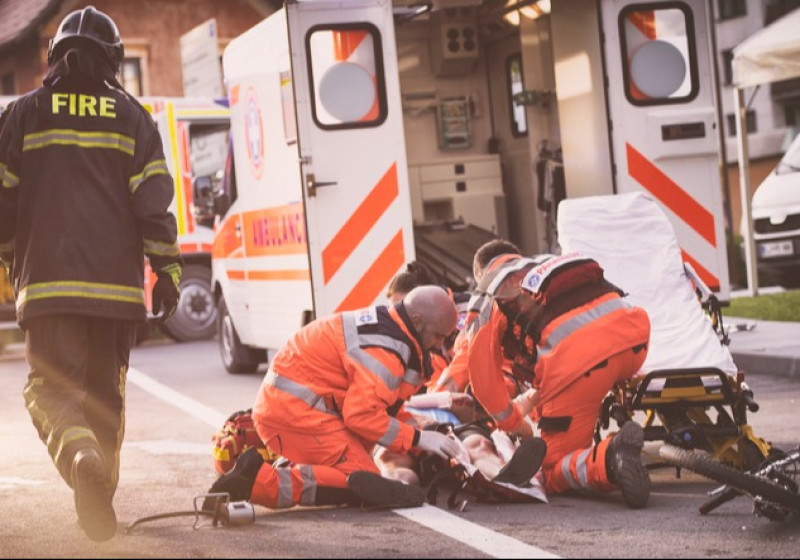
In EMS, sometimes it’s all you can do to get a patient to the hospital alive, and it’s okay to celebrate that victory. However, to take your skills as a provider to the next level, the key is to reflect on every call, identify things that could have gone better, and apply those lessons to subsequent calls. It’s easy to recognize things that went well, but finding the faults in the treatment you rendered can be hard. Here’s a case that could have gone better and a bit of explanation for why that could be. Of course, some details have been changed for clarity and to protect the anonymity of the patient and other providers, but generally, here’s how it went:
I was dispatched to intercept a neighboring agency, reportedly transporting four critical trauma patients between two ambulances after a bad motor vehicle collision a long way from town. They had tried to fly the patients, but inclement weather meant the helicopter couldn’t reach them. By the time we reached the intercept location, other patients had already been offloaded, and only one ambulance remained, parked on the side of the highway with its emergency lights on. When we knocked and opened the rear doors, we found the crew of three performing chest compressions on an elderly male, eager to have some assistance. We caught them at a rhythm check, and the patient was in v-fib, so the crew delivered defibrillation as we climbed into the ambulance to help.
My partner jumped on the chest, relieving an EMT who had reportedly given about 10 minutes of chest compressions. The patient was intubated and had significant “seatbelt signs” from the wreck—it looked like the seatbelt had torn the skin on his chest, in addition to the usual bruising. After receiving a brief history, I asked if the crew had tried decompressing the chest yet. There was some discussion about whether it would be necessary, as the patient did not show signs of pneumothorax before he arrested; however, he did have a flail segment in his chest wall and diminished lung sounds on the same side.
We proceeded with bilateral needle decompression, which I performed from near the patient’s hip, and got a lot of blood out of one of the needles. After decompression, lung sounds improved slightly but were still diminished on the flail-segment side. Another unit arrived with a LUCAS device, and after some difficulty positioning it correctly on his chest, we got it set up on the patient. Sadly, after 20 minutes or so, we consulted with medical control and terminated resuscitation efforts.
There’s no way to sugarcoat it; this would be a hard call for any paramedic to handle. The crews on scene were short on resources and a long way from help, and overall, I think they did a fantastic job in the face of such adversity. I’m not going to pick apart any of the choices they made before I got involved because I wasn’t there, and Monday morning quarterbacks don’t help anyone. After reviewing the call with my partner and others who were on the call, I’ve come to a few solid learning points for the next time I run into a traumatic arrest. It’s worth noting that, generally, we don’t work many traumatic arrests in my county. There is some evidence, though, that if a trauma patient has signs of life (pulse, breathing, etc) on EMS arrival, their likelihood of survival to discharge is comparable to any other witnessed cardiac arrest.1
While in a medical arrest, we presume that some cardiac event caused the arrest; however, in trauma arrests, we need to find and fix the underlying cause.2 The challenging part is that, in many cases, we can’t fix the underlying cause in the field; they need a surgeon to do that. In the field, the primary cause of a traumatic arrest is hemorrhage. Therefore, we must work quickly to control bleeding if there is an external injury. Place a tourniquet or pack wounds as appropriate. Additionally, we can use a pelvic binder to potentially control some internal bleeding in the pelvis. If you’re going to run the code, it’s probably worth placing a pelvic binder, even if you don’t think the pelvis is broken: you’re unlikely to cause any harm by placing it, and they are relatively inexpensive to replace compared to other items you’ll use to run your code. Finally, keep the patient warm, as hypothermia interferes with clotting and is associated with increased mortality in trauma patients.3
The second main cause of a traumatic arrest is an airway problem. Once major hemorrhages are controlled, we need to address the airway. In trauma, the airway of choice is an endotracheal tube because it provides the most direct path for ventilation into the lungs and, by inflating the cuff, will keep at least some blood or other fluids from entering the lungs.4 Supraglottic airways like iGels are also a great choice; if they are working well, they should be left in place.4 For some providers, a surgical airway may be an option to address trauma to the upper airway.
The third main cause of traumatic cardiac arrest is anything obstructive in nature. Think tension pneumothorax and cardiac tamponade, especially in any patient with trauma to the chest. Some studies have recommended bilateral decompression of the chest in all traumatic cardiac arrests, with the logic that decompression is unlikely to cause worsening of the patient’s condition and may address the underlying cause of the arrest.2 Finger thoracostomy, which is not commonly part of the EMS scope of practice, is the preferred method, but needle thoracostomy is more likely within our scope in the field.2 Some providers may be able to perform pericardiocentesis, draining fluid from the pericardial sac via a needle, to address cardiac tamponade in the field.
In addition to addressing underlying causes, a few other points should be emphasized:
- Doing chest compressions for ten minutes without a break isn’t ideal. Responders typically rotate every five cycles (two and a half minutes), and there’s good evidence that the quality of compressions declines rapidly if you try to push beyond that point without any break.5
- A choice must be made regarding continuing resuscitation en route to the hospital or terminating in the field. We know that as providers, we don’t give quality manual compressions in a moving ambulance (not to mention the safety concerns of standing for prolonged periods and delivering compressions unrestrained). However, the bumps and corners of a roadway don’t hinder mechanical CPR devices.6 While in a medical arrest, there isn’t much more definitive care that a hospital could offer, for a traumatic cardiac arrest patient, there might be an intervention that we can’t perform in the field (like surgery) that could improve the outcome. There isn’t a lot of good data on this, so you’ll have to weigh your options and make a decision using your best judgment, but it might be reasonable to transport to the hospital if you have a mechanical CPR device giving compressions. If you’re unsure, consult medical control, and always follow your local protocols.
- Performing needle decompression from the patient’s hip area isn’t something I had practiced, so it was a little bit awkward. Typically, I have performed the skill near the patient’s head, so this orientation was “upside down” for me. Paramedics are constantly tasked with overcoming challenging scenes and logistical hindrances, so practicing skills “out of position” should be a regular part of our training (and will be a bigger part of my training moving forward). Still, part of overcoming these challenges is optimizing positioning when possible. I probably should have either moved to a better position or passed the task to someone better positioned to perform it.
- It seemed strange to see a shockable rhythm in a traumatic arrest—in my experience with past traumatic arrests, all of them were in a type of PEA, but that’s just anecdotal. Finally, consider that your patient could have had a medical event that caused a traumatic event (cardiac arrest while driving, for example) or could be having a really bad day with a medical arrest after a traumatic event! When the mechanism doesn’t seem to account for a fatality, that’s a red flag, and you should think twice about a possible medical event.
- 1. Evans, C. C., Petersen, A., Meier, E. N., Buick, J. E., Schreiber, M., Kannas, D., & Austin, M. A. (2016). Prehospital traumatic cardiac arrest: Management and outcomes from the Resuscitation Outcomes Consortium Epistry-Trauma and PROPHET registries. The Journal of Trauma and Acute Care Surgery, 81(2), 285–293. https://doi.org/10.1097/TA.0000000000001070 https://doi.org/10.1097/TA.0000000000001070
- 2. Evans, C., Quinlan, D. O., Engels, P. T., & Sherbino, J. (2018). Reanimating Patients After Traumatic Cardiac Arrest: A Practical Approach Informed by Best Evidence. Emergency Medicine Clinics of North America, 36(1), 19–40. https://doi.org/10.1016/j.emc.2017.08.004 https://doi.org/10.1016/j.emc.2017.08.004
- 3. Azarkane, M., Rijnhout, T. W. H., van Merwijk, I. A. L., Tromp, T. N., & Tan, E. C. T. H. (2023). Impact of accidental hypothermia in trauma patients: A retrospective cohort study. Injury, 110973. https://doi.org/10.1016/j.injury.2023.110973 https://doi.org/10.1016/j.injury.2023.110973
- 4. Kovacs, G., & Sowers, N. (2018). Airway Management in Trauma. Emergency Medicine Clinics of North America, 36(1), 61–84. https://doi.org/10.1016/j.emc.2017.08.006 https://doi.org/10.1016/j.emc.2017.08.006
- 5. Lancaster, G. D., Stilley, J. D., & Franke, W. D. (2022). How Does Rescuer Fitness Affect the Quality of Prolonged Cardiopulmonary Resuscitation? Prehospital Emergency Care, 26(2), 195–203. https://doi.org/10.1080/10903127.2021.1894275 https://doi.org/10.1080/10903127.2021.1894275
- 6. Sunde, K., Wik, L., & Steen, P. A. (1997). Quality of mechanical, manual standard and active compression-decompression CPR on the arrest site and during transport in a manikin model. Resuscitation, 34(3), 235–242. https://doi.org/10.1016/s0300-9572(96)01087-8 https://doi.org/10.1016/s0300-9572(96)01087-8
- Dozens of courses and topics
- State-specific requirements
- We report to CAPCE in real time


